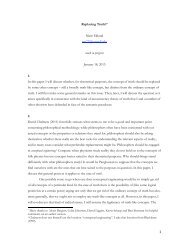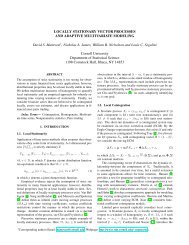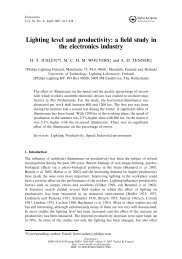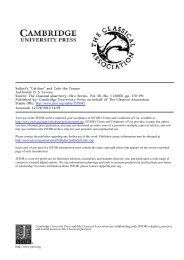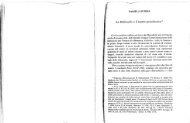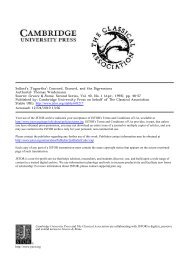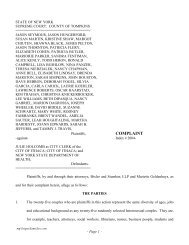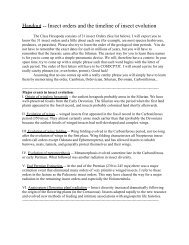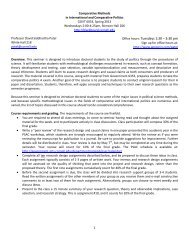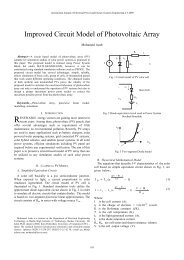Chapter 1 Review of Basic Semiconductor Physics - courses.cit ...
Chapter 1 Review of Basic Semiconductor Physics - courses.cit ...
Chapter 1 Review of Basic Semiconductor Physics - courses.cit ...
You also want an ePaper? Increase the reach of your titles
YUMPU automatically turns print PDFs into web optimized ePapers that Google loves.
Je<br />
<br />
Jh<br />
n<br />
<br />
<strong>Semiconductor</strong> Optoelectronics (Farhan Rana, Cornell University)<br />
rqnreErqDenr <br />
rqprhErqDhpr <br />
r 1 <br />
Je<br />
rGerRer t q<br />
<br />
r 1 <br />
J rG rR r p<br />
t<br />
q<br />
<br />
<br />
<br />
h<br />
<br />
<br />
h<br />
<br />
<br />
<br />
rErqprnrNrNr h<br />
d<br />
<br />
a<br />
When solved with proper boundary conditions, these equations determine the electron-hole dynamics in<br />
most semiconductor devices.<br />
1.8.5 Electron-Hole Recombination-Generation and Minority Carrier Lifetimes:<br />
There are different mechanisms by which electrons and holes recombine. We will go into the details later<br />
in the course. Here we give a simple qualitative expression for the case <strong>of</strong> minority carriers. In a p-type<br />
semiconductor, electrons are the minority carriers and holes are the majority carriers and n p . In a ntype<br />
semiconductor, holes are the minority carriers and electrons are the majority carriers, and p n . In<br />
equilibrium, generation and recombination rates are always equal. They differ only in non-equilibrium<br />
situations. We consider a non-equilibrium situation in a p-type semiconductor in which the electron and<br />
hole concentrations are slightly perturbed from their equilibrium values given by n o and p o ,<br />
2<br />
respectively ( no<br />
ni<br />
po<br />
). In this case, one can write the net recombination rate as,<br />
n n<br />
R<br />
o<br />
e Ge<br />
<br />
e<br />
where e is the minority carrier (i.e. electron) lifetime. In equilibrium, n no<br />
, and Re Ge<br />
, as it must<br />
be. If holes are the minority carriers, then one can write,<br />
p p<br />
R<br />
o<br />
h Gh<br />
<br />
h<br />
In equilibrium p po<br />
and Rh Gh<br />
. In intrinsic semiconductors the expressions for recombinationgeneration<br />
are more complicated and we will examine them later in the course.<br />
1.8.6 Bands and Band Diagrams in Real Space:<br />
Recall that the total energy <strong>of</strong> an electron in a crystal is a sum <strong>of</strong> kinetic and potential energies, and this<br />
total energy P.E<br />
K.E is what is plotted in k <br />
E vs k <br />
band diagrams. Now suppose an electric field is<br />
r <br />
E r<br />
<br />
present inside a semiconductor. The electrostatic potential associated with an electric field <br />
satisfies<br />
<br />
<br />
Er<br />
r<br />
<br />
In the presence <strong>of</strong> an electric field the potential energy <strong>of</strong> the electrons gets an additional term q r <br />
<br />
<br />
.<br />
This addition shifts the energies <strong>of</strong> all the bands in real space as a function <strong>of</strong> position. In particular, the<br />
conduction band minimum E c in real space is given by the equation<br />
<br />
Ec<br />
r Ec<br />
roqrro and similarly.<br />
<br />
Ev<br />
r Ev<br />
roqrro 1<br />
1 <br />
Er Ec<br />
r Ev<br />
r q q



